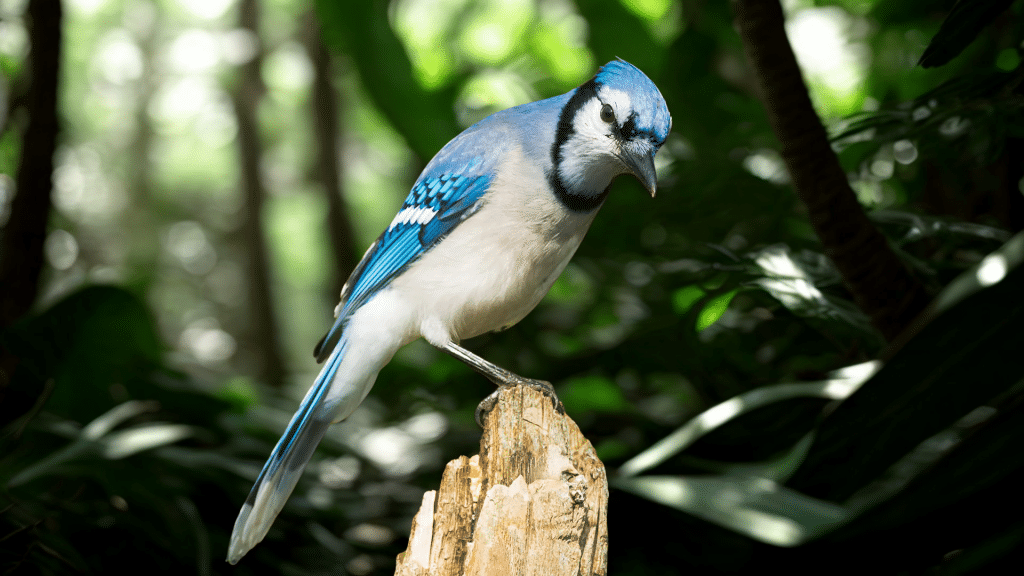You know that moment when something bright blue catches your eye in the trees? And you think, “Was that just another bird?”
Nope! That’s a blue jay making its grand entrance.
These guys are basically the rock stars of your backyard. Loud, flashy, and way smarter than they look.
Most people think blue jays are just pretty birds that make noise. But trust me, they’re hiding some wild secrets.
Want to know what makes these blue beauties so special? Buckle up – you’re about to see blue jays in a whole new way!
All About Blue Jays
Blue jays belong to the same family as crows and ravens, which helps explain their high intelligence.
Their history goes back about 2.5 million years. Over time, they made their homes in the eastern and central parts of North America, especially in oak forests where acorns are abundant, an important food source for them.
Today, blue jays can be found across the eastern and central United States, southern Canada, and areas east of the Rocky Mountains.
These birds have been part of the region’s natural and cultural history for centuries, appearing in many Native American stories.
One of the most noticeable things about blue jays is their bright blue feathers. This color is not caused by pigment but by tiny structures in their feathers that scatter light to create the blue effect.
Inside their feathers, there is brown pigment, which becomes visible if a feather is damaged or crushed, causing the blue color to vanish.
Physical Features of Blue Jays
| Feature | Description |
|---|---|
| Belly | White |
| Crest | Blue crest on the head |
| Neck Markings | Black markings around the neck |
| Tail Feathers | Blue and black striped |
| Size | 9 to 12 inches (22 to 30 cm) long |
| Weight | 2 to 4 ounces (65 to 109 grams) |
| Beak | Short, strong, and pointed |
Interesting Facts About Blue Jays
Blue jays have many unique habits that make them stand out. Here are some facts that show what makes these birds so special.
1. Using Ants as Bath Soap
Blue jays have a strange habit called Anting. They rub ants on their feathers before eating them.
Some ants produce an acid that tastes bad, so blue jays remove it by rubbing the ants on their feathers first. This helps the ants taste better and may also keep the birds’ feathers clean.
2. Transport Nuts Over Long Distances
Unlike many other nut-caching birds, blue jays can carry and bury nuts several thousand meters away from the original source.
This long-distance transport plays a significant role in spreading tree populations, such as beech and oak, helping forests expand and regenerate over large areas
3. Masters of Mimicry
These birds are good mimics, capable of copying the calls of hawks to scare other birds away from food.
Sometimes, they even imitate sounds made by cats, dogs, or car alarms. Some blue jays can even mimic human words, showing just how clever they are.
4. Social Gatherings
When blue jays gather, their group is called a party or a band. They take turns leading the group during flight, showing teamwork and cooperation.
5. Stay With One Partner
Once blue jays choose a partner, they usually stay together for life, sharing responsibilities like building the nest, incubating eggs, and feeding their young.
Parent blue jays can make over 100 trips a day to feed their babies, starting early in the morning and continuing until sunset.
6. Plant Trees by Accident
Blue jays bury acorns and nuts to save for winter, but many of these acorns are forgotten and later grow into new oak trees.
One blue jay can bury thousands of acorns in a season, helping forests grow.
7. Throats Work Like Bags
Blue jays have a unique pouch in their throat that can hold several acorns or nuts at once.
They can carry up to four large acorns in their mouth and throat pouch, which is impressive for their size.
And helps them bring back enough food to their nests or hiding places without making many trips.
8. Hold Funerals for Others
When a blue jay finds a dead hawk or owl, many other blue jays gather around and make loud calls.
They fly around the dead bird for up to 30 minutes. Scientists believe this behavior warns others about dangers nearby or helps them deal with the loss.
9. Very Brave Bird Fighters
These birds are fearless when it comes to protecting their nests. They will attack bigger animals like cats, hawks, and owls if they come too close.
They dive from above and peck hard, making many larger birds avoid nesting nearby during breeding season.
10. Babies Need Lots Of Help
Baby blue jays are born without feathers and cannot see at first. It takes about 3 weeks for them to grow feathers and learn to fly.
Their parents keep feeding them even after they leave the nest, sometimes for several weeks, teaching them survival skills.
11. Love to Play Games
These birds enjoy playing games. They have been seen sliding down snowy roofs and tossing sticks to each other.
Sometimes, they even drop and catch objects in mid-air just for fun. Playing helps blue jays stay active and sharp.
12. Among the Most Accurate Visual Predators
In scientific experiments, blue jays demonstrated an exceptional ability to detect camouflaged prey, such as moths hidden against complex backgrounds.
They use a highly focused search strategy to spot subtle visual cues that humans often miss, showing advanced visual attention and hunting skills
13. Each Has Unique Stripes
The black stripes on a blue jay’s face work like a mask. Each bird’s pattern is different, similar to human fingerprints.
These markings help blue jays recognize family members and tell who belongs in their group.
14. Collect Paint Chips for Calcium
Blue jays have been observed chipping off and collecting light-colored paint from houses.
This unusual behavior is thought to be a way for them to gather calcium, which is important during the spring breeding season.
Providing alternative calcium sources, like crushed eggshells, can help stop this behavior if it becomes a nuisance
15. Can Live Fifteen Years
In the wild, blue jays usually live around 7 years, but some have lived over 15 years.
Birds that get food from people tend to live longer than those living deep in forests. The oldest known wild blue jay lived for more than 17 years.
BONUS TIP: To attract blue jays set up platform feeders filled with peanuts, sunflower seeds, and acorns. They love bathing, so a birdbath is a must. Offer them small pieces of suet during winter months when food is scarce.
Wrapping It Up
So there you have it – blue jays are pretty incredible. Next time one of these blue beauties shows up in your yard, you’ll know you’re looking at a real character.
They’re not just pretty birds making noise.
They’re little comedians sliding down roofs, tiny gardeners planting trees, and fierce protectors of their families.
Who would’ve thought your backyard visitor was such a cool neighbor? Keep your eyes peeled for that flash of blue.
Now you know there’s always something interesting happening when a blue jay’s around.




















